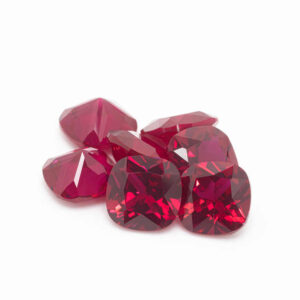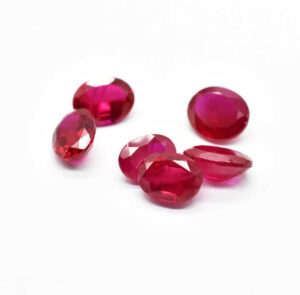Synthetic rubies have a fascinating history that dates back over a century. As one of the first lab-grown gemstones successfully produced on a commercial scale, synthetic rubies have played a vital role in both the jewelry industry and high-tech applications. In this article, we will explore how long synthetic rubies have been around and highlight some key historical milestones that shaped their development and widespread use.
How Long Have Synthetic Rubies Been Around?
The story of synthetic rubies begins in the early 20th century. In 1902, the French chemist and physicist August Verneuil invented the flame fusion process (also known as the Verneuil method), the first practical technique for producing synthetic rubies. This groundbreaking method involves melting pure aluminum oxide powder doped with chromium in a high-temperature flame, allowing the formation of ruby crystals virtually identical to natural ones in chemical composition and physical properties.
This invention marked the beginning of synthetic ruby production, which quickly became commercially viable by 1903. Since then, synthetic rubies have been available for over 120 years, transforming from a scientific curiosity into a valuable material widely used in jewelry and industrial applications.
Key Historical Events in the Development of Synthetic Rubies
1902 – Invention of the Flame Fusion Process
August Verneuil’s development of the flame fusion method was revolutionary. It enabled the mass production of synthetic rubies at a fraction of the cost of natural stones, making rubies more accessible for decorative and industrial uses.
1903 – Commercial Production Begins
Following Verneuil’s invention, synthetic rubies quickly entered the market. Their affordability and high quality allowed jewelers and manufacturers to incorporate these gems into various products, expanding the availability of ruby-colored stones worldwide.
1910s-1920s – Industrial Applications Take Off
Beyond jewelry, synthetic rubies found use in industrial settings, particularly in precision instruments such as watch bearings and mechanical components, leveraging their hardness and durability.
1960 – Birth of the Synthetic Ruby Laser
A landmark moment came in 1960 when American physicist Theodore Maiman built the world’s first laser using a synthetic ruby crystal as its gain medium. This breakthrough sparked the modern laser era and cemented synthetic ruby’s role as a critical material in scientific and medical technologies.
1930s-1960s – Advances in Ruby Synthesis Techniques
New methods emerged to improve synthetic ruby quality, including:
- High-Pressure High-Temperature (HPHT) Method: Simulates natural conditions to produce high-quality crystals.
- Flux Growth Method: Uses molten flux to slowly grow crystals, producing rubies with inclusions similar to natural ones.
These techniques allowed scientists to create synthetic rubies with enhanced clarity, color, and structural properties.
1980s-Present – Acceptance in the Jewelry Market
As consumer awareness of ethical sourcing and environmental concerns grew, synthetic rubies gained popularity as an eco-friendly and conflict-free alternative to mined stones. Many jewelry brands now feature lab-grown rubies, offering beautiful, affordable, and sustainable options.
Why Does This History Matter?
The more than 120-year history of synthetic rubies reflects a remarkable journey of innovation and adaptation:
- Scientific Achievement: Synthetic ruby production represents one of the earliest successes in material science, paving the way for other lab-grown gemstones.
- Industrial Revolution: The use of synthetic rubies in laser technology revolutionized industries from medicine to communications.
- Ethical and Environmental Impact: Lab-grown rubies reduce the need for mining, lessening ecological damage and social conflicts associated with gemstone extraction.
Conclusion
Synthetic rubies have been around since 1902, thanks to August Verneuil’s invention of the flame fusion process. Over the past century, they have evolved from scientific novelties to indispensable materials in both jewelry and advanced technology. Understanding this history enriches our appreciation of synthetic rubies not just as beautiful gems, but as products of remarkable human ingenuity with lasting impact on industry and society.
Whether you are a gem enthusiast, jeweler, or tech professional, knowing the timeline and significance of synthetic ruby development helps highlight their unique place in the modern world.







